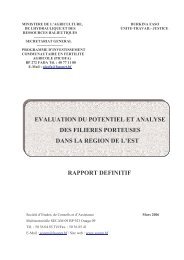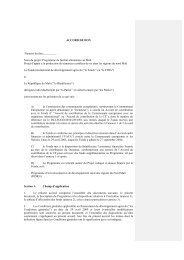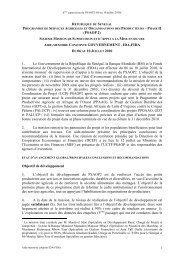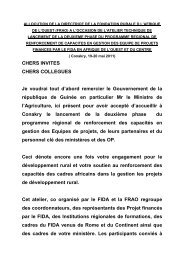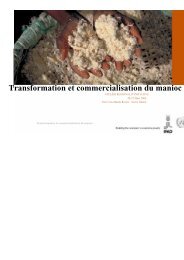Scaling Up the Fight Against Rural Poverty - FIDAfrique
Scaling Up the Fight Against Rural Poverty - FIDAfrique
Scaling Up the Fight Against Rural Poverty - FIDAfrique
Create successful ePaper yourself
Turn your PDF publications into a flip-book with our unique Google optimized e-Paper software.
components of <strong>the</strong> process as distinct and separable phases each of which has its own important role to<br />
play.<br />
4. Not every innovation can or should be scaled up. Not every scaling up needs to involve an<br />
innovation.<br />
Many innovations may not be suitable for scaling up. It is precisely <strong>the</strong> experimental nature of <strong>the</strong><br />
innovation process that needs to be recognized as important it its own right and <strong>the</strong> risk of pilots not<br />
succeeding must be accepted as an integral part of <strong>the</strong> innovation and learning process. Failed pilots<br />
may offer as many lessons as successful ones. But of course, failed or unsustainable pilots should not<br />
be scaled up. By <strong>the</strong> same token, not every scaling up effort needs to involve an innovation generated<br />
by IFAD. As we shall see in <strong>the</strong> examples cited throughout this report, many of <strong>the</strong> cases where IFAD<br />
has successfully scaled up involve ideas or innovations that o<strong>the</strong>rs had first piloted. This is<br />
appropriate: what matters most is to improve <strong>the</strong> lives of as many rural poor as possible.<br />
5. <strong>Scaling</strong> up involves two types of possible errors: “type 1 error” – too little scaling up; and “type 2<br />
error” – wrong scaling up.<br />
Much attention in <strong>the</strong> scaling up literature and also in this review of IFAD’s experience focuses on <strong>the</strong><br />
prevailing lack of attention to scaling up – what we refer to as a “type 1 error”. But <strong>the</strong>re are also cases<br />
where scaling up takes place, but is done in a wrong way – a “type 2 error”. The latter type of error is<br />
found more frequently in <strong>the</strong> large development banks, such as <strong>the</strong> World Bank, which can and often<br />
do aim to go to scale in <strong>the</strong>ir country strategies and programs. Evaluations of <strong>the</strong>ir programs have<br />
critiqued insufficient piloting, testing and learning as well as inappropriate phasing of approaches that<br />
gets in <strong>the</strong> way of effectively operating at scale.<br />
C. Designing pathways of innovation, learning and scaling up<br />
In general <strong>the</strong>re are many possible pathways for scaling up a successful intervention. By “pathway” we<br />
understand <strong>the</strong> sequence of steps that need to be taken in <strong>the</strong> innovation-learning-scaling up cycle to<br />
assure that a successful pilot is taken from its experimental stage through subsequent stages to <strong>the</strong><br />
scale ultimately judged to be appropriate for <strong>the</strong> intervention pursued. For each case IFAD needs to<br />
explore potential pathways early on and take proactive steps to plan and prepare for scaling up – in<br />
terms of dimensions, desired ultimate scale, drivers and spaces, IFAD’s operational modalities,<br />
intermediate results, and monitoring and evaluation.<br />
Selecting <strong>the</strong> “dimensions”: <strong>Scaling</strong> up pathways can follow different “dimensions”. They may simply<br />
expand services to more clients in a given geographical space. They can also involve “horizontal”<br />
replication, from one geographic area to ano<strong>the</strong>r; “functional” expansion, by adding additional areas of<br />
engagement; and “vertical” up-scaling, i.e., moving from a local or provincial engagement to a<br />
national-wide engagement, often involving policy dialogue to help achieve <strong>the</strong> policy and institutional<br />
conditions needed for successful national level scaling up.<br />
Defining <strong>the</strong> desired scale: It is important to define up-front <strong>the</strong> ultimate scale to which an intervention<br />
should or could be taken, given <strong>the</strong> needs of <strong>the</strong> target population and <strong>the</strong> nature of <strong>the</strong> intervention,<br />
and to consider realistically <strong>the</strong> time horizon over which <strong>the</strong> scaling process needs to extend in order to<br />
achieve <strong>the</strong> desired ultimate scale. Hartmann and Linn (2008) found that successful scaling up of<br />
programs to national scale can take five to ten years, or longer.<br />
Focusing on key drivers and spaces for scaling up: There are two sets of factors that need to be<br />
considered in designing <strong>the</strong> appropriate pathway for any given case (Hartmann and Linn, 2008):<br />
• “drivers” – <strong>the</strong>se are <strong>the</strong> forces pushing <strong>the</strong> scaling up process forward (see Box 1); and<br />
• “spaces” – <strong>the</strong>se are <strong>the</strong> opportunities that can be created, or potential obstacles that need to be<br />
removed to open up <strong>the</strong> space for interventions to grow (see Box 2).<br />
11





